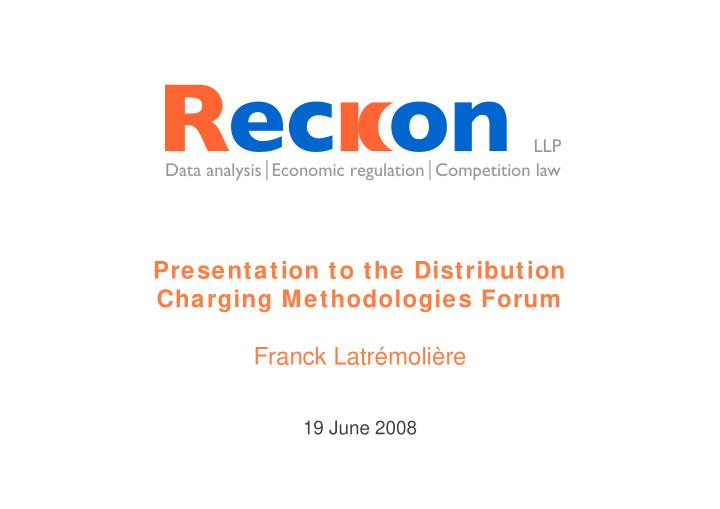



LLP Data analysis Economic regulation Competition law Presentation to the Distribution Charging Methodologies Forum Franck Latrémolière 19 June 2008
What is exploitative abuse? • Infringement with direct impact on a customer – Not necessarily anti-competitive conduct – Distinct from exclusionary or discriminatory abuse • United Brands (ECJ) / Napp (CAT) formulation – “has made use of the opportunities arising out of its dominant position in such a way as to reap trading benefits which it would not have reaped if there had been normal and sufficiently effective competition” • Identify market features to show difference from normal and sufficiently effective competition 1
Does the price control not address these problems? • The price control prevents overall exploitation • But competition law protects each customer – cf. English Court of Appeal in Napp: “the Tribunal convincingly demonstrated that the [Pharmaceutical Price Regulation Scheme] outcome, precisely because of its "portfolio" base, is irrelevant in the case of over-pricing of any particular product” • No “State action” defence – Ofgem does not direct use of any charging method 2
LRMIC example • Load: 49 MVA. Capacity: 50 MVA. Cost: £5m. • Growth 0.25%: 8 years to go. PV of cost: £3m. • Additional 1 MVA adds £2m of PV (£5m – £3m) • Annualise over 40 years: £150/kVA. • Would imply charges of more than £5m a year. • Might a large customer on this circuit complain that this seems higher than a reasonable return? 3
Why is stand-alone rebuilding cost relevant? • Find market features which restrict competition – Planning, wayleaves, special rights in licence, etc. • Imagine that these market features do not apply – i.e. anyone can build distribution network elements • Identify evidence of exploitative abuse – i.e. if the market features lead to higher prices – The relevant benchmark is a price that gives a reasonable return on the stand-alone cost of rebuilding the network elements 4
Might there be an objective justification? • Even if the price is higher than in the hypothetical more competitive market, it might be justified – Investors are entitled to a reasonable return – DNOs are entitled to apply incentives on customers • Justification is subject to proportionality – Only to the extent necessary to achieve objectives – For example, price control revenue target (fair return) does not justify large locational differences • For LRMIC: look for necessary incentive effect 5
LRMIC as justification? • Marginal change in present value amount reflects expenditure caused by sustained change in load – Sensible basis for an incentive • LRMIC examples spread the present value of all investment on increment between now and 2048 – Only load at the time of reinforcement affects cost? – No good reason found — this is fatal to justification • Reasonable incentive could not have been greater than return on stand-alone rebuilding cost 6
Can FCP lead to similar issues? • FCP uses foreseeable expansion expenditure, spread over total load, over fixed 10-year window – Past load is deemed to have paid its fair share – Time profile seems arbitrary — but is it reasonable? • Excessive geographical differentials very unlikely • Theoretical risks are in the opposite direction – Could connected customers close to GSP complain? – Is there dominance / relevant market features? – Possible justifications, e.g. smooth transition? 7
Recommend
More recommend